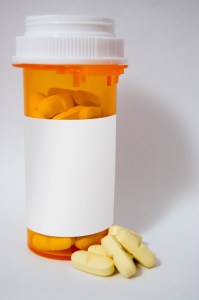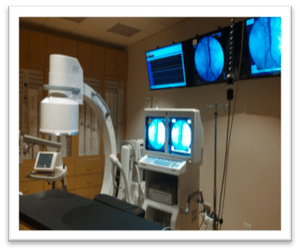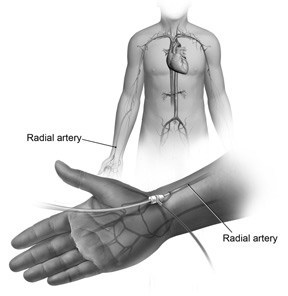What is Coronary Stent Implantation?
A stent is a mesh wire which acts as a scaffolding to keep an artery open to ensure blood flow.
Blockages are due to the formation of fatty plaques known as atherosclerosis. When this plaque ruptures, a clot will form leading to further obstruction of the artery. When this condition affects the vessels of the heart it is called coronary artery disease.
Most coronary blockages are treated with balloon angioplasty and coronary stenting. Angioplasty is the stretching of an artery to widen it, followed by stent placement. This is known as percutaneous coronary intervention (PCI).
Since the restenosis (re-narrowing) rate is high in angioplasty, a stent is often placed to ensure the blood flow and patency of the artery.
Stents may either come as a bare metal stent or a drug eluting stent. Drug eluting stents slowly release a medication to prevent the artery from becoming blocked again.
Why Do I need it?
Angioplasty is useful in treating blockages in the coronary arteries when medications or lifestyle changes are not enough to improve blood flow.
Stenting is used to treat symptoms caused by coronary artery disease including symptoms of chest pain, shortness of breath, palpitations, or extreme weakness.
In emergency situations such as a heart attack, stenting can be done as soon as possible to retrieve blood flow back to the heart.
How to prepare for the procedure:
Before the procedure:

You will be asked to have blood work done some time before the procedure.
Do not eat or drink anything from midnight the night before your procedure. You may have small sips of water to take your medicine. The procedure is usually done in the morning.
If taking anticoagulants such as Coumadin, you may be asked to stop 5 days before the procedure.
If you are diabetic and taking oral medications, you may be asked not to take it the morning of your procedure. If you are taking insulin, you may be asked to take half the dose you normally take.
Avoid using any medications used for erectile dysfunction including Viagra, Cialis, and Levitra) 4 days before the procedure.
Check with Dr. Jamnadas several days before the procedure to determine which medications you may need to stop.
The possible risks and benefits will be explained to you and any questions you or your family may have will be answered before your procedure.
Remove nail polish, necklaces, rings, bracelets, and any other jewelry before the test.
You will be admitted into the hospital so be prepared with an overnight bag.
Make arrangements to have someone drive you to and from the hospital. You will not be permitted to drive after the procedure.
Bring a list of the names and dosages of all the medications you are on.
Let us know if you have had any previous allergic reactions to a contrast dye, iodine, or history of bleeding problems.
You will be asked to empty your bladder before the procedure.
During the procedure:
The procedure will be carried out at the hospital in the Cardiac Catheterization Laboratory (Cath Lab).
During the procedure you will lay awake on a table on your back.
Several electrodes will be attached to your arms, legs, and chest. These electrodes have leads that will connect to an electrocardiogram (EKG) machine that records the electrical activity of the heart throughout the test.
An I.V. will be inserted into your arm or hand. From this I.V. a sedative will be given to you to help you relax.
Under sterile precautions, Dr. Jamnadas will inject a local anesthetic until you are fully numb in the area where the catheter will be inserted. The catheter can be inserted either into the radial (wrist), brachial (inside your elbow), carotid (neck), or most commonly the femoral (groin) artery.

Photo of CVI’s Cath Lab

Illustration of the radial approach for catheterization.
The radial approach may be better suited for you rather than the femoral approach for the following reasons:
- Limited bed rest after the procedure, usually only 15 minutes. It is easy on patients with back problems or patients who can not lie down for a long period of time.
- Does not require pressure on the groin.
- Less bleeding risks.
- Do not need to stop anticoagulants before the procedure.
A small incision is made in the skin, and a needle is used to enter the artery. A guide wire is threaded into the artery. A short plastic tube known as a sheath is slipped over the guide wire and into the artery. The guide wire is then removed. Once the sheath is in place, the catheter can be inserted.
A contrast dye will be given to view the arteries and seen under x-ray guidance. This allows Dr. Jamnadas to see the exact number, location, and size of the blockage.
Once the blockage is located, the catheter is advanced through the artery to the narrowed segment. A balloon is then inflated, compressing the plaque against the artery wall.
Since the restenosis (re-narrowing) rate is high in angioplasty, a stent is often placed to ensure and maintain blood flow.
There are two types of stents, bare metal stents and most of them today are drug coated called drug eluting stents.
- Bare metal stents act as a scaffolding to keep an artery open, but suffer from a 30-40% restenosis rate. This is due to a process called intimal hyperplasia which is attributed to a keloid. A keloid is an overgrowth of the inner lining of the blood vessel that covers over the stent. However, this reparative process lasts no more than 6 minutes. After 6 minutes, if an artery has not re-narrowed at the site of the stent, it is unlikely to re-narrow.
- Drug eluting stents have a less aggressive reparative process and therefore the narrowing rate within the stent is less than 5%. Drug eluting stents are one of the marvels of modern cardiology. Typically if a year has gone by with no evidence of re-narrowing, then that portion of the artery that has been stented will remain patent indefinitely in 99% of patients.
If symptoms of angina reoccur after one year, it is usually due to NEW blockage in a DIFFERENT part of the artery, therefore risk factor modification is needed to prevent new blockages. ** Many people have the misguided understanding that patients who have received multiple stents over the course of years have had stent failures. In the vast majority of these cases, it is a stent in a New location that was needed.
Following stent placement in addition to atherosclerosis risk factor modification, patients need to be put on two antiplatlet therapies. Plavix or Effient + Aspirin are recommended for one uninterrupted year of antiplatlet therapy.
It is important to know that a Plavix sensitivity test is done for those who have a drug eluting stent to assess patients responsive to Plavix. Those who are sensitive and have the drug eluting stent will require Plavix therapy up to 1 year until the stent is covered by the natural lining of the blood vessel wall. This also helps in preventing blood clots from forming. For those with a bare metal stent applied, 1 month of Plavix therapy is required.
After the procedure:
Once the procedure is done, the puncture site in the artery will be closed.
You need to remain lying down for several hours.
If the insertion site was in the groin, the introducer sheath is usually removed within 6 hours of the procedure. You may need to lie down for 2-6 hours without bending or lifting your leg.
If the catheter was inserted into your wrist or arm, you will be permitted to get out of bed sooner.
After this you will be allowed to move about freely. This does not allow strenuous activity up to 1–2 days.
A nurse will monitor your heart rate, blood pressure, temperature, and the insertion site.
You will be asked to drink plenty of fluids after the procedure to flush out the contrast dye from your system.
It is normal to have a small bruise or lump at the insertion site. This should disappear in about 2 weeks.
What are the risks?
Stenting is a common interventional procedure, although with any medical procedure it carries risks.
Most of the complications, if they occur are minor and temporary.
These include:
- Allergic reaction: may have an allergic reaction to the contrast dye.
- Nausea and Vomiting
- Bleeding, bruising, or swelling at the insertion site
- Blood clot formation
- Restenosis
- Arrhythmia: irregular heart rhythm
- Infection
- Damage to the heart or blood vessels
- Kidney damage: due to the contrast material which could possibly cause kidney failure.
- Heart attack or stroke: on rare occasion, the catheter may dislodge a clot or debris from the inside wall of the artery
What are the benefits?
-
Stenting can restore blood flow in the artery without requiring a major surgery.
-
Does not require an incision.
-
General anesthesia is not required.
-
Recovery time is short.
-
Can be done within an hour of an emergency situation such as heart attack to reverse damage.
-
You may feel better than you have felt in a long time.


